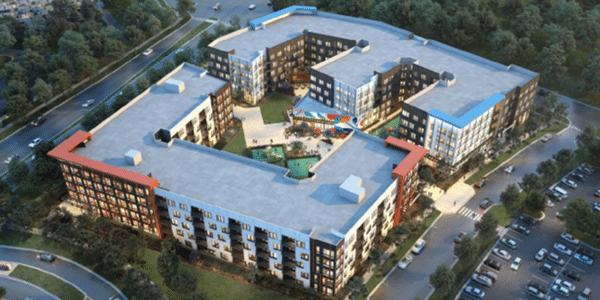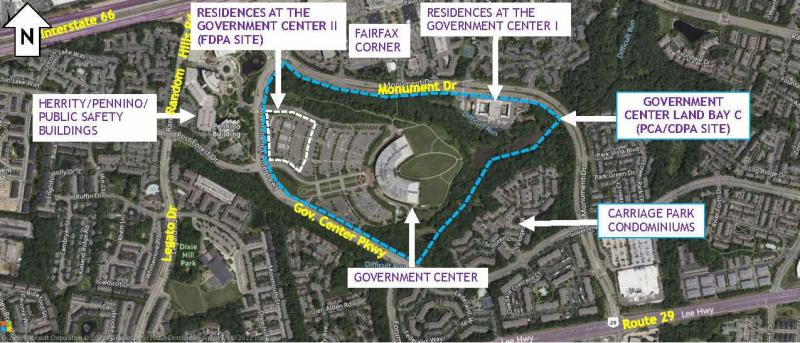‘Public Land for Public Good’ Produces VA Affordable Housing

By Mark Fogarty
7 min read
Virginia residents who want to work for Fairfax County or make their views known on matters pending before the county government now may not have far to go, thanks to a Low Income Housing Tax Credit project being developed by Lincoln Avenue Communities (LAC) on an underused parking lot at the county Government Center using an innovative “quadruplet” structure.
According to Nick Bracco, vice president and regional project partner at Los Angeles-based Lincoln Avenue, the 279-unit development follows a decision made by the county to pursue a “public land for public good” policy.
This involves parcels of public land being transferred by the county Board of Supervisors to the Fairfax County Redevelopment and Housing Authority for affordable housing.
“We were fortunate enough to be selected by Fairfax County as the development partner in February 2022. There’s a good public-private story here,” Bracco says.
“This one was particularly exciting because it’s right in front of the county center,” he says. (The project is called The Residences at Government Center II because there is a prior, unaffiliated development elsewhere on the grounds. Lincoln Avenue is in the process of finalizing a new development name to further differentiate the two.)

“It’s a testament to the county’s desire to put its money where its mouth is,” says Bracco.
This is Lincoln Avenue’s first deal with the county. The transaction closed and construction commenced in early November. Lincoln Avenue’s projection is 22 months before the first residents move in. The units are income-restricted between 30 and 70 percent of area median income (AMI), averaging below 60 percent.
Thirty percent of the units are restricted to families earning at or below 50 percent AMI. Income averaging is being used on the four percent credit units, but not on the nine percent.
The unit mix is family-focused with a unit breakout of 96 one-bedroom units, 137 two-bedrooms and 46 three-bedrooms.
Bracco anticipates that residents will mostly be working-class and county government workers. Some will receive project-based vouchers from the county.
An Innovative Structure
The Northeast phase of development was awarded competitive nine percent tax credits by Virginia Housing, the state housing finance agency, in 2023 and again in 2024. The deal was complicated in that there were two sections to the development, and each was awarded both four and nine percent LIHTCs in a unique quadruplet structure.

Explaining the innovative structure, Bracco says, “The Virginia Housing Qualified Allocation Plan (QAP) provides a points incentive for twinned nine/four deals, so the plan was always to complete a twinned transaction.”
Bracco adds, “The initial thought process was to execute a single nine/four twinned deal. The quadruplet concept was born in late 2022 as a response to the inflationary pressures in the construction market and the run-up in interest rates. These market conditions made a single twin unfeasible.
“While executing on two nine/four twins at different times was possible, closing all four deals at the same time ensured we could build the shared parking garage as efficiently and cost-effectively as possible.”
The development secured an award of competitive nine percent LIHTC from Virginia Housing for the Northeast phase in June 2023.
“LAC decided to invest to complete the construction documents for the entire development upon award of the initial Northeast nine percent credits,” says Bracco.
“While there was some risk in expending these dollars, LAC knew this put us in the best position to win the nine percent credits for the Southeast phase. Additionally, it allowed us to close as quickly as possible following receipt of the nine percent credits on the Southeast phase.”
The development was awarded nine percent LITHC credits for the Southeast phase in June 2024.
“Lastly,” Bracco says, “to facilitate the quadruplets, we moved forward on our tax-exempt bond allocations and four percent LITHC applications for the Northwest and Southwest before the second nine percent award. This was done to align the various timelines necessary to facilitate closing.”
As far as the look of the building, “The design (by KTGY) was created to allow a combination of things,” Bracco says, including “public and private access through the courtyard space. Because it is part of the Government Center, we wanted to create the ability for folks to walk back and forth between the various government buildings. We were also focused on ensuring that the residents had outdoor amenity spaces so they could enjoy the playgrounds or go out and have a meal outside. That was important.”
The Residences at Government Center II have 15,000 square feet of community space. The bulk of it is in a 10,000-square-foot daycare center. The balance is set to be a flexible space for other programming, such as financial literacy and job training.
“We’re excited to be able to include what I think is going to be a great community asset,” Bracco says.
The development will also feature an array of green features, including:
- Solar array on the roof;
- Designs to meet Earthcraft Gold certification;
- Watersense Low Flow fixtures;
- LED lighting throughout the property;
- Energy Star appliances;
- Energy Star windows;
- Seven EV charging stations on the property; and
- The infrastructure to facilitate additional EV stations if necessary.
The total development cost is approximately $145 million. Approximately $62 million was provided through tax credit equity, with Capital One as the investor and Hudson Housing as the syndicator. There were four permanent loans through Freddie Mac, with Capital One as the servicer.
Credit-enhanced bonds were used on the four percent deals, while Freddie’s affordable housing forward product was used for the nine percent.
Cash Collateralized Bond Structure
“We executed on a cash collateralized bond structure, so we were able to increase our four percent equity through the use of a taxable construction loan and the additional basis it generated.”
Having all four phases of the deal closing simultaneously made it a “logistically challenging” financing, Bracco says. “There were some complexities associated with that, but we had a good team of folks and worked through it.”
Bracco answers, “Absolutely!” when asked if LAC wanted to do more deals of this type.
“We hope this is the first of many. Fairfax County has been great to work with, we hope to develop much-needed affordable housing in Fairfax County and Northern Virginia.”
Fairfax County made a $25 million contribution of subordinate financing. There was also a deferred developer’s fee on the deal.
County officials were effusive about the project at the groundbreaking.
“For years, I’ve felt that we could make better use of the sea of parking in front of the Fairfax County Government Center to help meet our affordable housing goals. I made the motion to convey the property to the FCRHA for that purpose, and today, we are seeing this concept come to fruition,” says James Walkinshaw, supervisor, Braddock District, Fairfax County Board of Supervisors.
A Crowded Groundbreaking
It was a crowded groundbreaking, featuring officials from LAC, local lawmakers and partners, including Virginia Housing, the Virginia Department of Housing and Community Development, the Fairfax County Redevelopment and Housing Authority, Freddie Mac and Capital One.
Speakers included U.S. Rep. Gerry Connolly, who represents Virginia’s 11th District in Congress; Bracco; Lenore Stanton, chair, Fairfax County Redevelopment and Housing Authority; Jeffrey C. McKay, chairman, Fairfax County Board of Supervisors; James Walkinshaw, Braddock District supervisor, Fairfax County Board of Supervisors; and Kerrie Wilson, CEO, Cornerstones.
Ed Delany, senior director for Community Finance at Capital One, said, “Capital One provided construction debt, LIHTC equity investments and permanent Freddie Mac loans, including structuring and closing Freddie Mac’s first Forward Bond Credit Enhancement in just 90 days to meet the closing timeline.”
The Residences at Government Center II will reflect its origins as a parking lot. There will be a hefty 331 parking spaces there for 279 apartments for both midrise structures. That’s a parking ratio of 1.3.
“We pushed the garage down and the units up,” Bracco said at the event. Harkins Builders is the general contractor.
LAC is a mission-driven acquirer and developer of affordable housing. It operates in 28 states and has a portfolio of more than 30,000 units at more than 170 properties.
